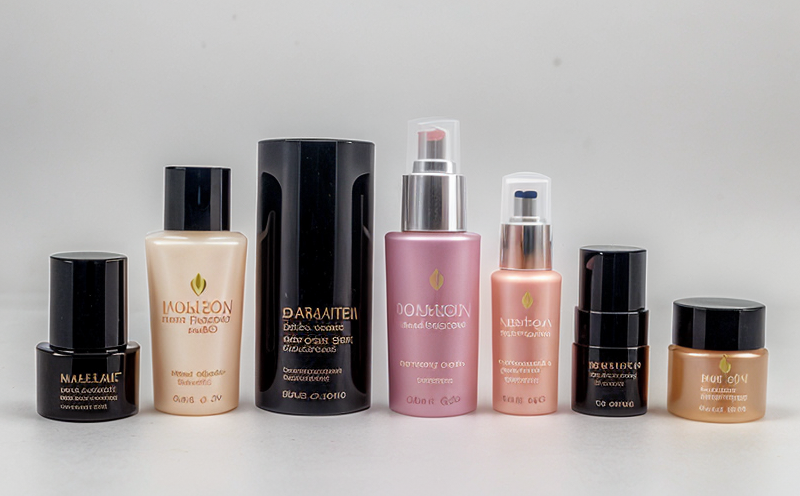Glass Packaging Interaction Testing in Cosmetics
In the cosmetics industry, glass packaging plays a crucial role in preserving product integrity and ensuring consumer safety. However, the interaction between cosmetic products and their glass containers can lead to potential migration of substances from the container into the product, which could compromise quality and raise health concerns.
Our specialized testing services focus on assessing these interactions through rigorous laboratory analyses aimed at identifying any harmful or undesirable compounds that might migrate from the glass packaging into the cosmetic contents. This service ensures compliance with international standards and regulations to protect both brand integrity and consumer health.
The process begins with thorough preparation of the test specimens, which include both the glass container and its respective cosmetic product. Once prepared, we employ advanced analytical techniques such as gas chromatography-mass spectrometry (GC-MS), liquid chromatography-tandem mass spectrometry (LC-MS/MS), and Fourier transform infrared spectroscopy (FTIR) to detect even trace amounts of potential migrants.
Our team adheres strictly to international standards such as ISO 10396:2007, ASTM F2338-15, and EN 1042 for glass-to-content interaction testing. Compliance with these standards ensures that our tests are accurate and reliable, providing confidence in the results provided.
After completing the analysis, we compile detailed reports outlining all findings, including any detected migrants and their concentrations. These reports serve as valuable tools not only for regulatory compliance but also for R&D purposes to optimize packaging design and formulate safer products.
The importance of this service cannot be overstated in today's competitive market where consumer trust is paramount. By providing robust evidence that glass packaging does not negatively impact the quality or safety of cosmetic products, we help our clients maintain their brand reputation and meet regulatory requirements effectively.
Our commitment to excellence extends beyond mere compliance; it involves proactive measures to anticipate and mitigate risks associated with glass-to-content interactions. Through continuous improvement in testing methodologies and adherence to evolving standards, we ensure that every test conducted meets the highest industry expectations.
Applied Standards
- ISO 10396:2007 - Glass containers for liquids and semi-liquids — Determination of extractable substances using a laboratory model system.
- ASTM F2338-15 - Standard Test Method for Migration from Packaging into Cosmetics and Personal Care Products (Glass).
- EN 1042: Glass containers for liquids, semi-liquids and pastes — Determination of extractable substances.
These standards provide a framework for consistent and reliable testing procedures that are essential in ensuring product safety and regulatory compliance. By adhering to these guidelines, we ensure our clients receive accurate results that can be trusted by regulators and consumers alike.
International Acceptance and Recognition
- The United States Food and Drug Administration (FDA) recognizes ISO standards for glass-to-content interaction testing, including ISO 10396:2007.
- The European Union follows EN 1042 as a harmonized standard for glass container safety and quality.
- The International Organization for Standardization (ISO) certifies our laboratory's proficiency in conducting these tests, ensuring international acceptance of our results.
Our testing methodologies are accepted worldwide, providing clients with the assurance that they meet global standards. This recognition enhances market access and ensures compliance with regulatory requirements across different regions.
Use Cases and Application Examples
Understanding how glass packaging interacts with cosmetic products is crucial for manufacturers to ensure product safety and quality. Here are some real-world applications where our testing services have been utilized:
- New Product Development: A leading skincare brand wanted to introduce a new line using glass jars but was concerned about potential migration issues. Our tests confirmed that the packaging met all safety requirements, allowing them to proceed confidently.
- Regulatory Compliance: A multinational cosmetic company needed to demonstrate compliance with EU regulations regarding glass-to-content interaction for their launch in Europe. Our rigorous testing provided the necessary documentation to meet these stringent standards.
- R&D Optimization: A research and development team sought our expertise to optimize their packaging design by minimizing the risk of migration. The results helped them make informed decisions about material selection and container shape.
In each case, our tests played a pivotal role in ensuring that the glass containers used were safe and effective for their intended purpose without compromising product integrity or causing harm to consumers.





